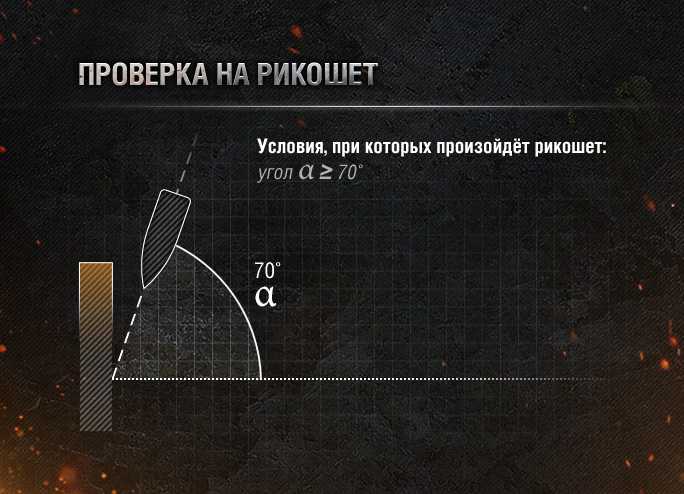Grazie a SilentStalker di FTR, possiamo leggere dal russo le spiegazioni ufficiali sul nuovo meccanismo dei rimbalzi. La traduzione inglese è opera di SilentStalker e potete visitarla al seguente indirizzo: http://ftr.wot-news.com/2014/09/15/9-3-ricochet-mechanics-explained/ quella originale in russo la troverete qui: http://worldoftanks.ru/ru/news/pc-browser/1/ricochet_game_mechanics_in_9_3/
A ricochet is a deflected shot, that hits the armor under a very steep angle. In World of Tanks case, if the AP or APCR (subcaliber) shell hits the armor under the angle of 70 degrees or greater, the shell will automatically ricochet – it will be deflected by the armor without doing any damage. For HEAT shells, the angle is 80 degrees. HE and HESH shells on the other hand do not ricochet at all. Ricochet check is performed when the shell hits the armor (normalization is performed after ricochet check).
- Un rimbalzo è un proiettile che colpisce la corazza al di sotto di un angolo molto acuto. In WoT, se AP o APCR colpiscono una corazza al di sotto dei 70 gradi o più, il proiettile sarà automaticamente rimbalzato non provocando danno. Per i proiettili HEAT l’angolo è di 80 gradi, per HE e HESH non vi è rimbalzo alcuno. Il controllo sul rimbalzo è effettuato quando il proiettile colpisce la corazza (quindi sempre, ndt).
Ricochet however does never happen when the “three calibers rule” is applied. This rule says that when the gun caliber (gun, not shell) is three times higher than the armor thickness, ricochets do not happen (HEAT shells do not use this rule however). Furthermore, ricochets do not happen when external modules of the tank are hit (tracks, optics and gun).
- Il rimbalzo comunque sottostà alla regola dei tre calibri, Cioè quando un cannone ha un calibro tre o più volte superiore allo spessore della corazza, il rimbalzo non avverrà (tranne gli HEAT che non sottostanno a questa regola). Inoltre, il rimbalzo non avviene quando vengono colpiti moduli esterni (come i cingoli o altro).
What is changed
Currently, two types of ricochets can happen. A shell can ricochet into a the tank (for example in a shot trap) – if, after it ricochets, the shell trajectory aims again at the tank, the shell tries to achieve penetration yet again. If it fails, it disappears. If the shell ricochets off the tank altogether in first place, it disappears.
- Cosa è cambiato?
- Al momento due tipi di ricochet possono accadere. Un proiettile rimbalza nel carro se dopo il rimbalzo la traiettoria del proiettile mira ancora verso il carro stesso, allora il proiettile prova a raggiungere la penetrazione della corazza una volta ancora. Se fallisce, allora sparisce. Più comunemente (il primo caso è assai raro, non credo mi sia capitato) se un proiettile rimbalza del tutto fuori dal carro, esso scompare
In 9.3, after the first ricochet happens, the shell will continue on new trajectory in any case (it does not disappear regardless of where it flies). When that happens, APCR and AP shells lose 25 percent from their base penetration value, HEAT shells keep the same penetration value. If the ricocheted shells (with reduced penetration) hits another vehicle, the hit will be calculated based on normal game mechanics. Second such ricochet is not possible (if the shell ricochets again, it disappears).
- Nella 9.3 dopo il primo rimbalzo, il proiettile continuerà sempre la sua corsa su una nuova traiettoria. Quando ciò succede, APCR e AP perderanno il 25% di penetrazione (rispetto alla penetrazione di base), le HEAT manterranno intatto il valore penetrante. Se i proiettili rimbalzati colpiscono un altro veicolo, il colpo verrà calcolato in base alle consuete meccaniche di gioco. Non sarà possibile un secondo rimbalzo (quindi niente flipper, intesi? ndt).
Ricochets of your shells, hitting an enemy and ricocheting off, damaging your teammate, will not be punished.
- Se un rimbalzo colpisce un veicolo alleato, non sarà soggetto a punizione.
